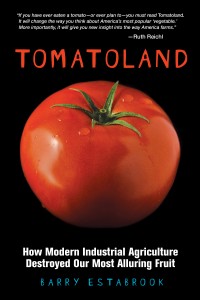Hi folks—I was going to finish up my review of Canned Goods Past in this one post, but the next project demands more space than it would have received in that format. So, for your enjoyment and edification, I present:
Crushed Tomatoes: An Interlude in Two Acts
Act I: Figuring It Out
As summer was ending, I felt strongly that we needed to can some tomatoes for use over the winter. And here’s why: I read a lot about food.
It all started a few years ago when I read a large chunk of Michael Pollan‘s revealing writing about food systems, which led me, through a series of similar books and movies (mostly about the horrors of the industrial food system in the U.S.), to a couple of books about tomato farming: Heirloom by Tim Stark and Tomatoland by Barry Estabrook.
Heirloom chronicles Stark’s transformation from management consultant to tomato farmer while also describing some of the most delicious-sounding tomatoes I’ve ever heard of: purple and yellow, meaty and juicy, striped and spotted. Just like when Michael Pollan lists different varieties of apples in The Botany of Desire, I was awed by the sheer array of fruit available to us.
Tomatoland made me want to take action, though. Estabrook makes it abundantly clear in his book that winter tomatoes are problematic for two very good reasons: 1) they are picked green and artificially ripened before being shipped to your local grocery, still hard as a rock and completely flavorless, and 2) the entire industry relies on slave labor to exist. I wish I were making this up, but I’m not. Read the book—it’s eye opening.
Combine those unsettling facts with:
- concerns about BPA in store-bought canned tomatoes,
- a fabulous recipe for crushed tomatoes courtesy of Canning for a New Generation,
- a challenge to can something bought in bulk from local farmers, issued by Joel Salatin of Polyface Farms in his book Folks, This Ain’t Normal (so many books!), and
- interest from friend Matthew in learning how to can
and you’ve got a perfect storm of tomato-canning inspiration.
Act 2: Making It Happen
So I inquired about buying tomatoes in bulk at the Nichols Farm stand at my local farmers market, where they were willing to give me an awesome deal on some of the season’s last Roma tomatoes; 30 pounds, in fact. The farmer who sold them to me looked doubtful that I had any idea what to do with them, but I ran right home and made a test run with the most beat-up looking individuals. Friend Matthew and his wife, friend Johanna, were coming over in a week to help process the majority of the tomatoes, but some of them weren’t going to last that long. LESSON #7: Can ’em while you’ve got ’em.
The tomatoes filled considerably fewer jars than I expected. Maybe the recipe was a little off (remember LESSON #4?) or maybe I was cutting away too much flesh around the core? In any event, the end product was gorgeous, so I was happy. And tired. Two batches of canned tomatoes took me four hours. LESSON #8: Bulk canning takes time and energy. Plan accordingly.
Cut to a week later when friends Matthew and Johanna (90 months pregnant) arrive, and the four of us (including husband Rob) made short work of the remaining haul from Nichols Farm, plus 10 pounds M+J brought with them. Everyone walked away with enough canned tomatoes (and juice) to last most of the winter. Success!
The moral of this story, I suppose, is that a) there are problems with the way we produce and consume food products in this country and b) there absolutely are solutions to those problems. Like a lot of things, the old ways are sometimes the best ways. LESSON #9: They weren’t canning in Ye Olden Days just for shits and giggles, folks.






